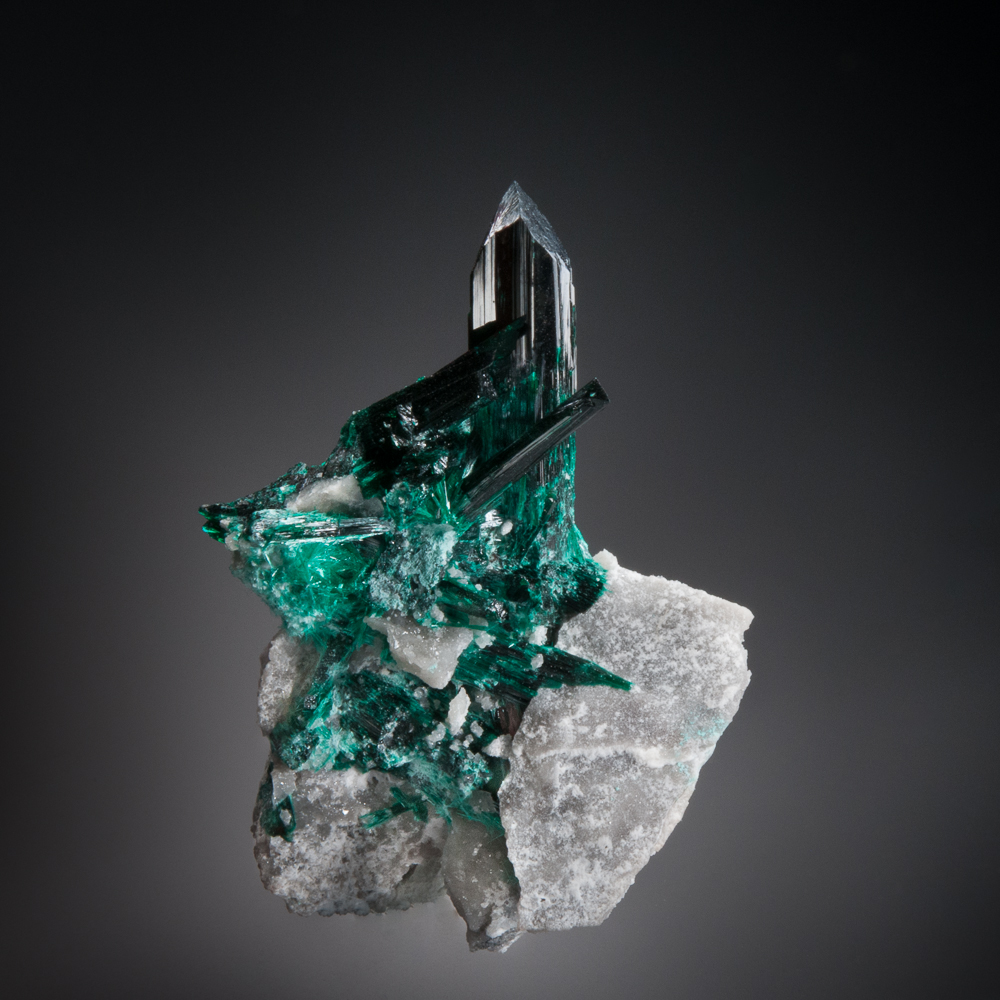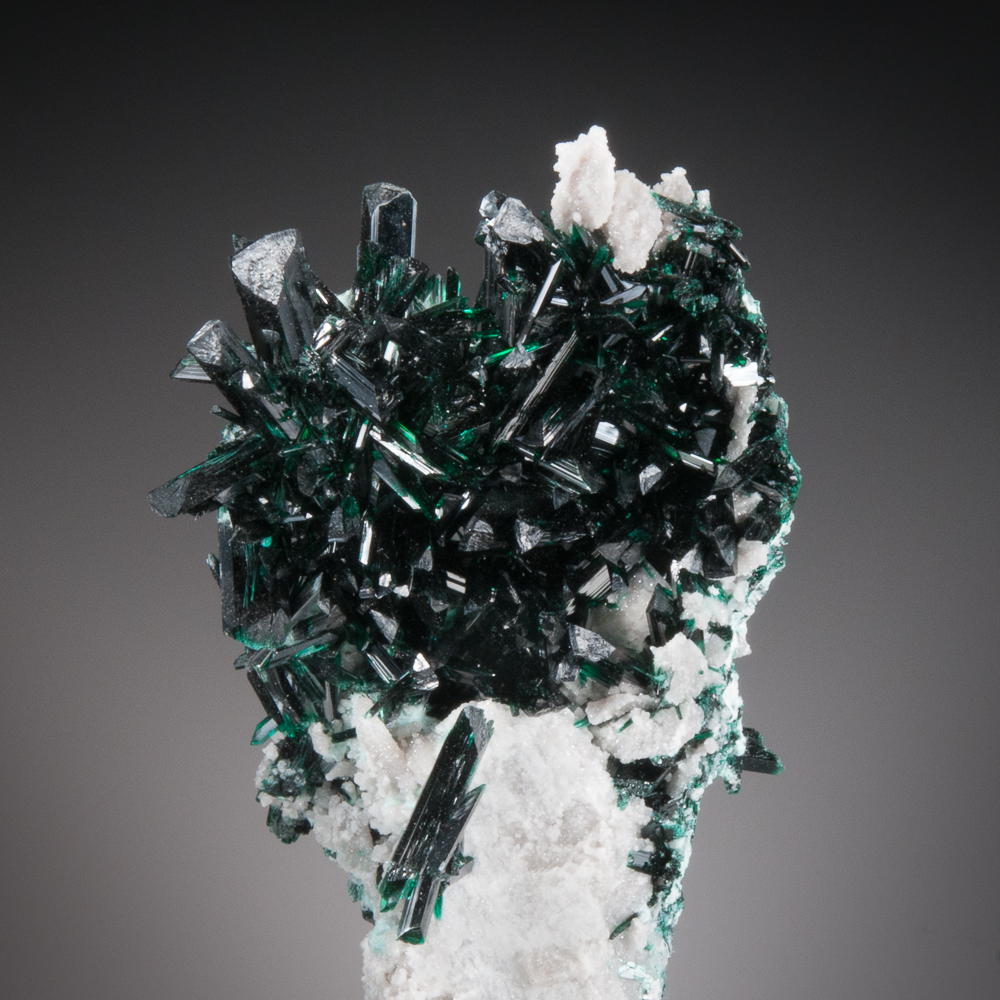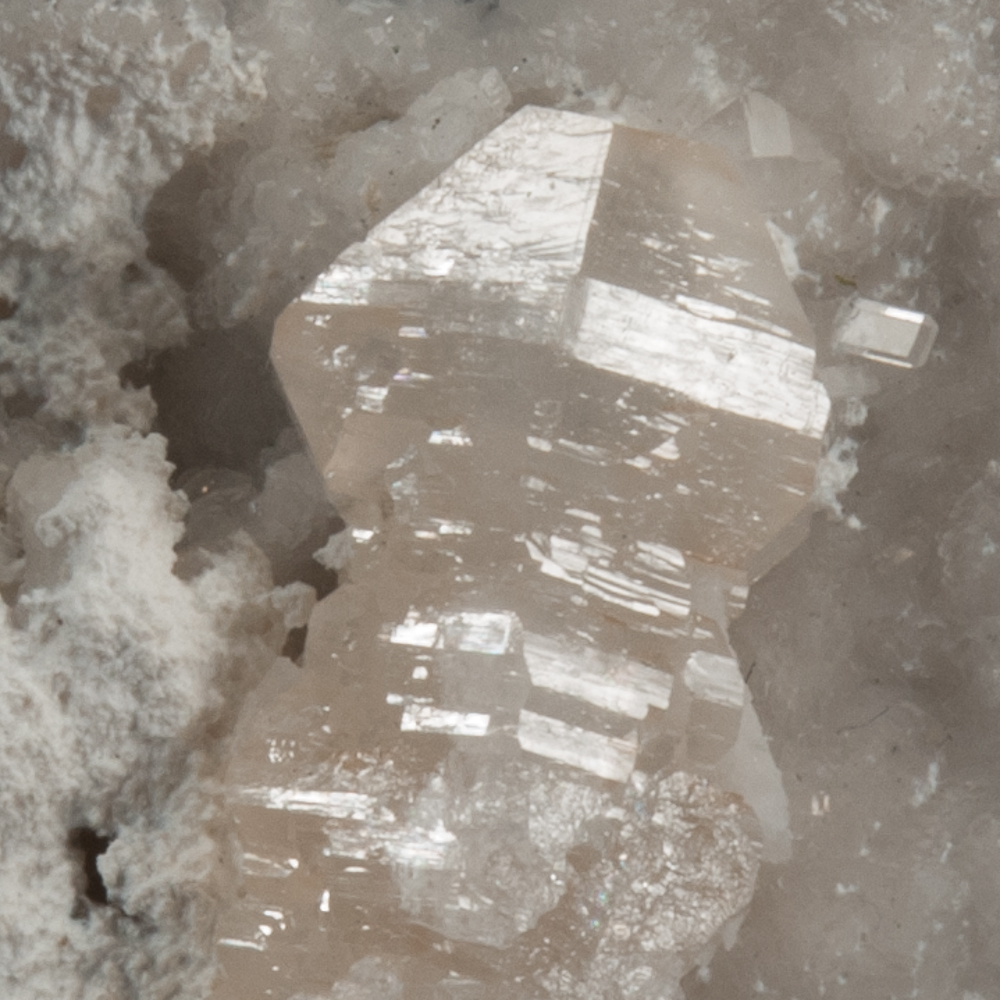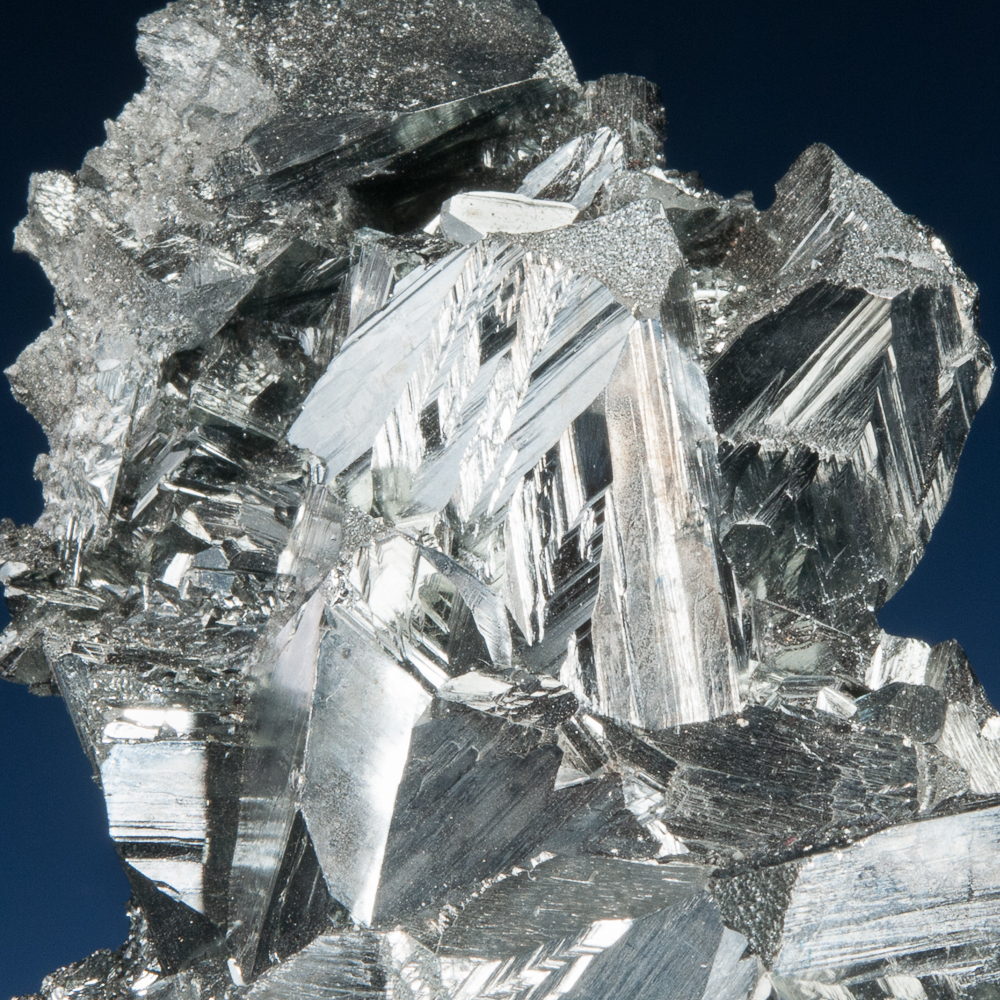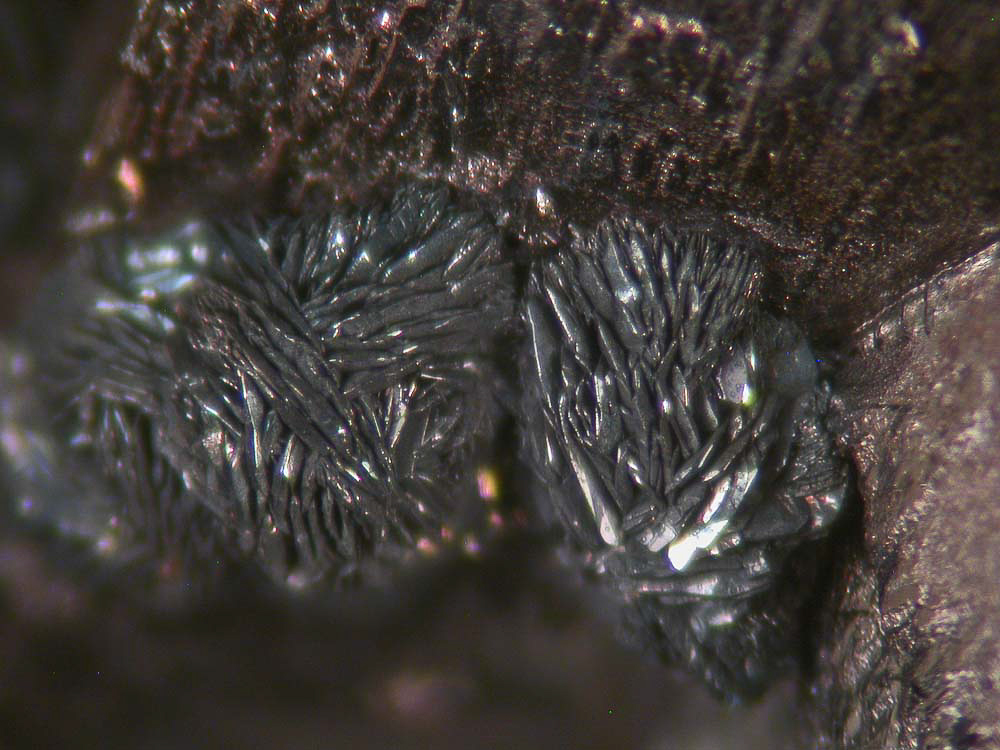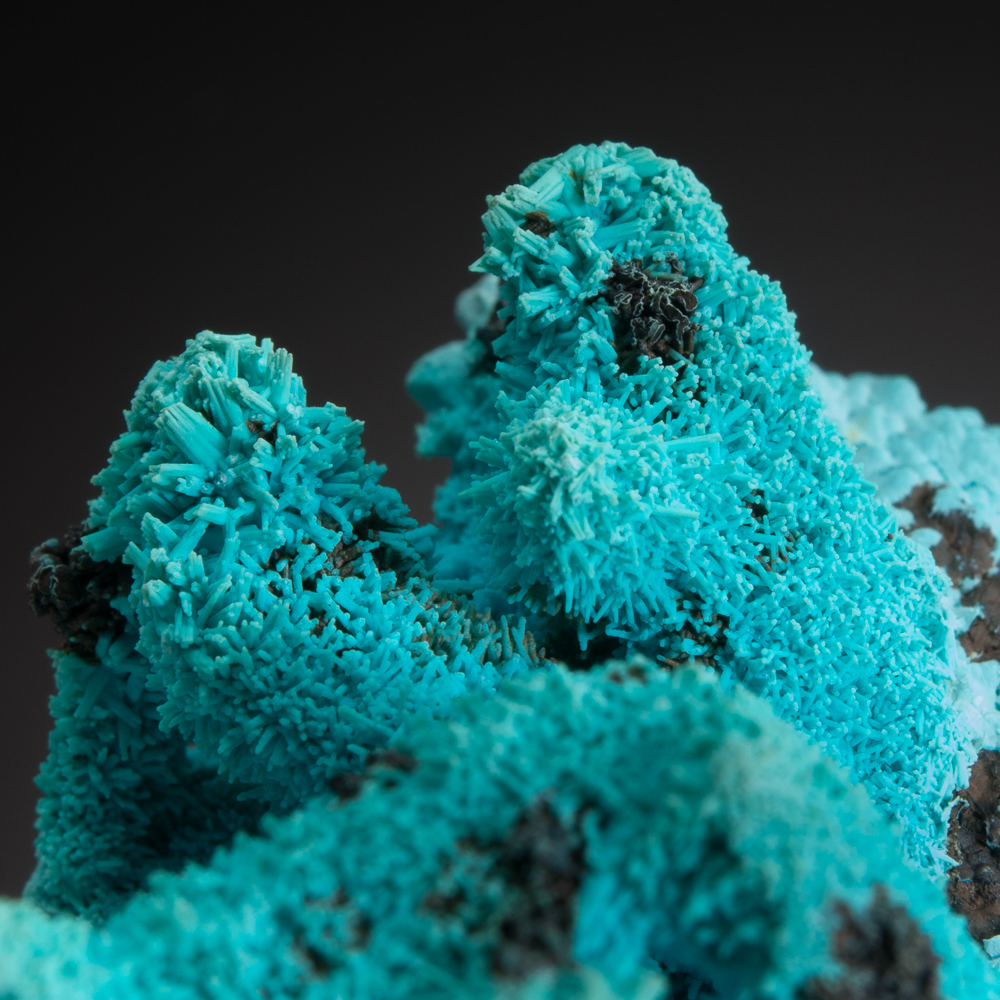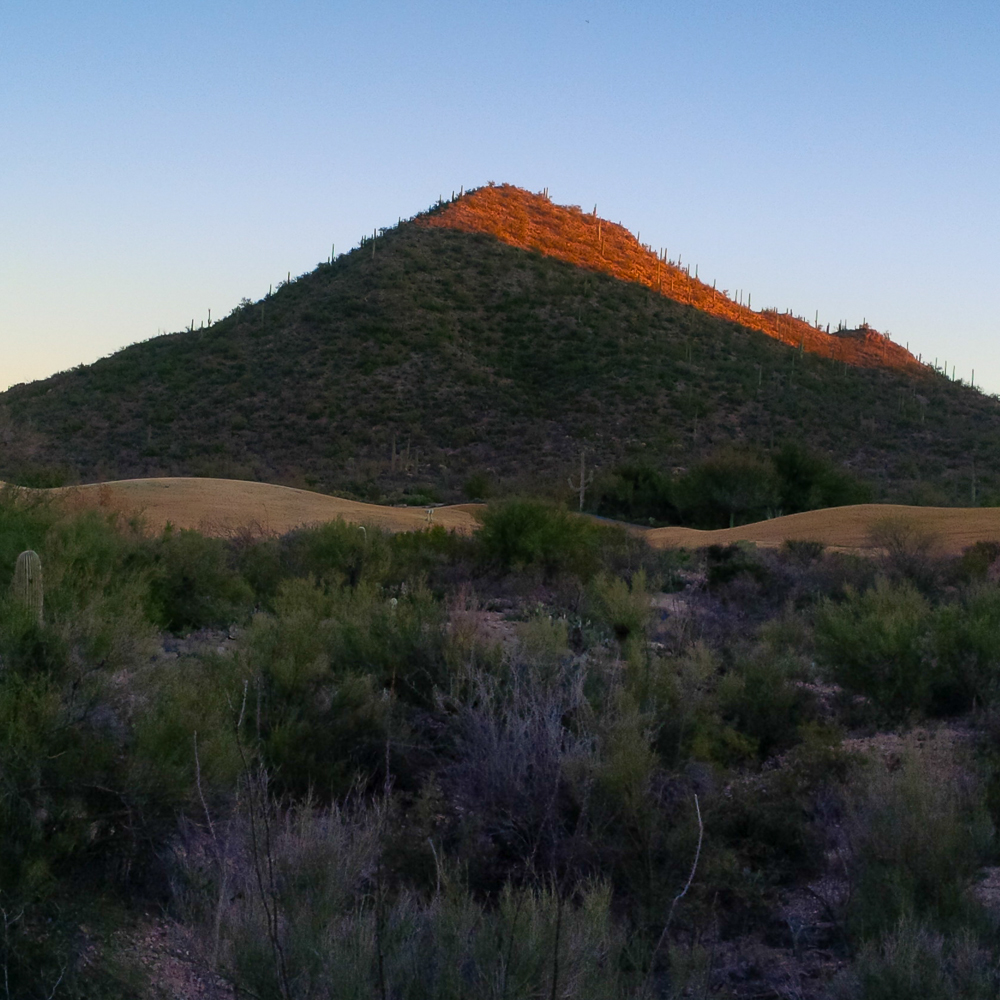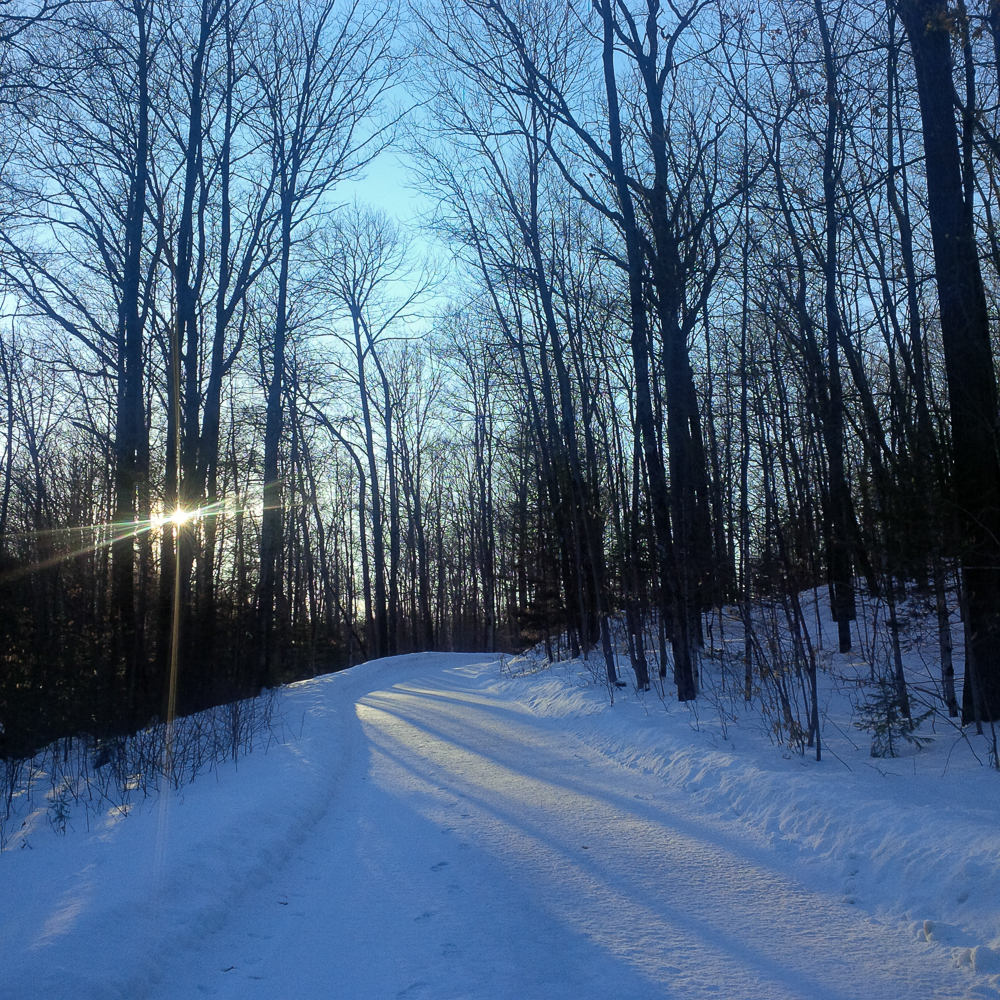Categories
Archives
I love arriving back in Tucson. Urban field collecting at its finest!
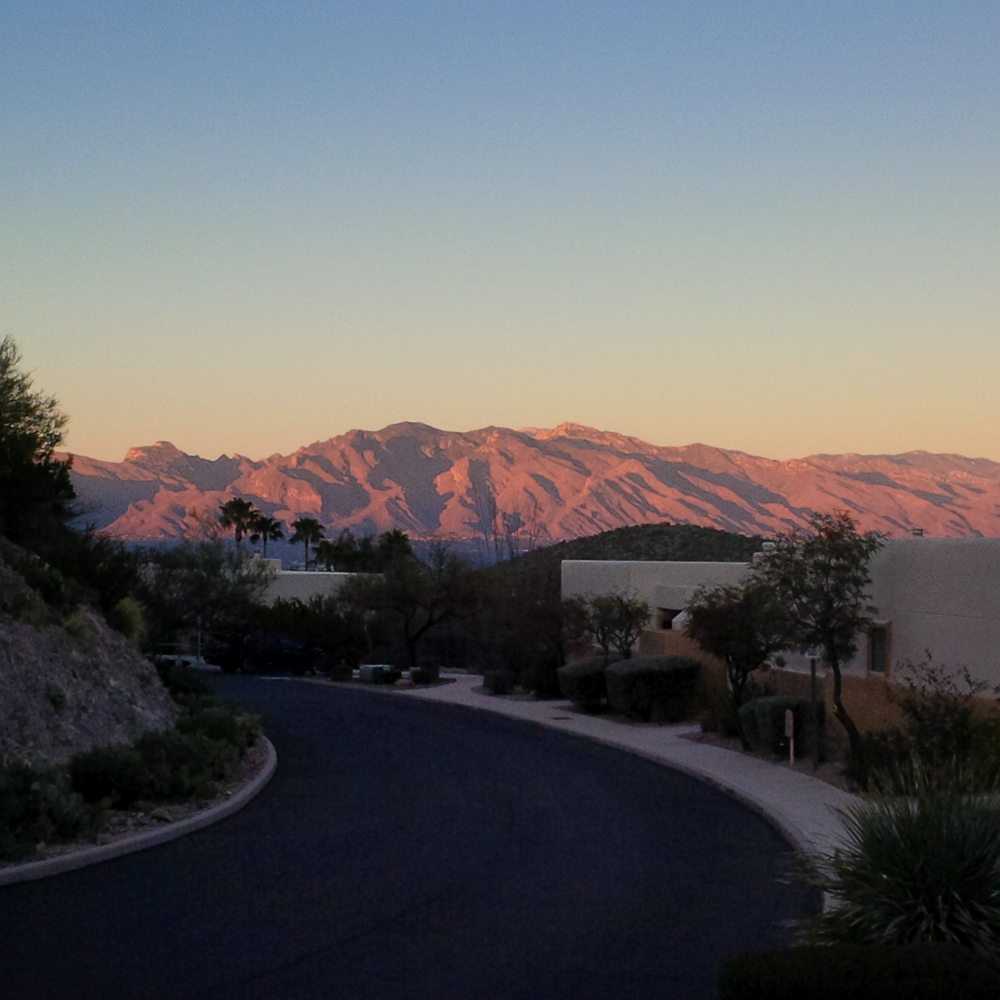
There’s an excitement about the Tucson shows – we all feel it.
A bit similar to the way a the Christmas tree each year is evocative of the fun of past Christmases, in Tucson we have our ornamental orange trees in the courtyard at the Hotel Formerly Known as The Inn Suites…
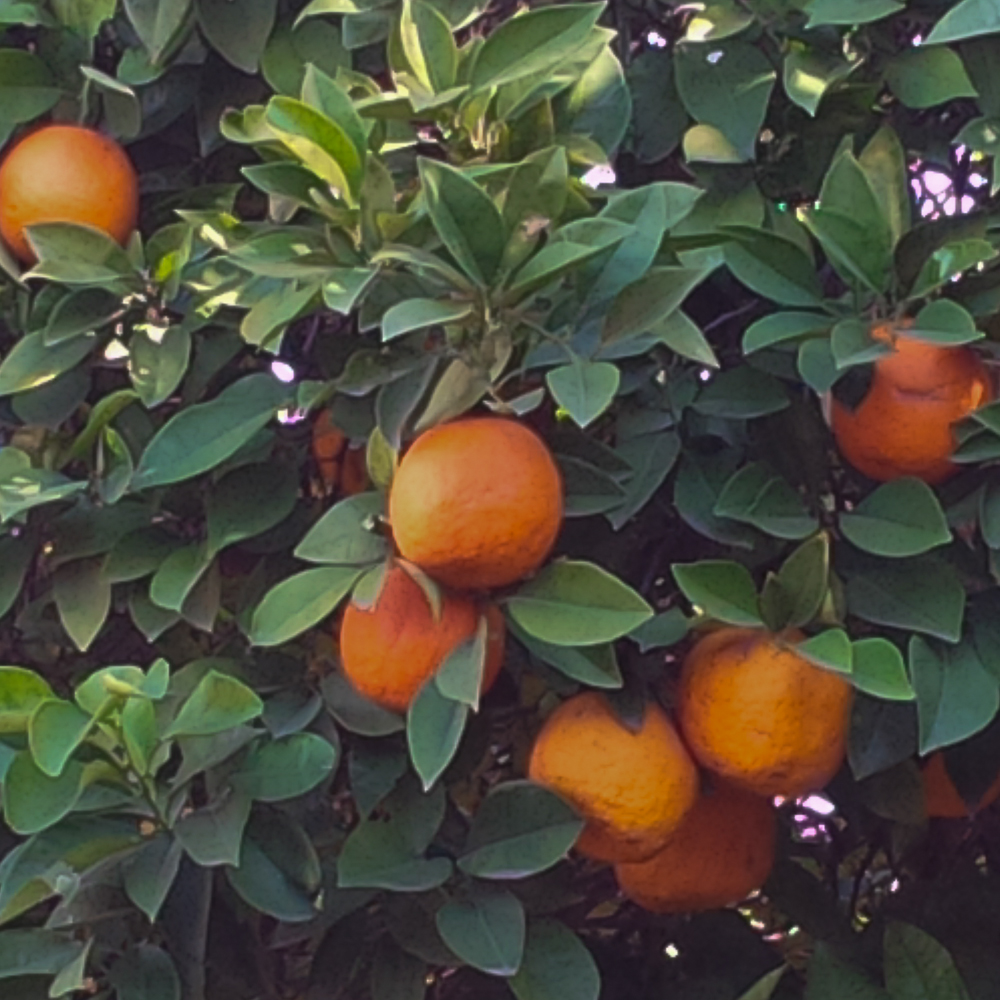
The mornings at the start of Tucson 2016 were not quite tropical.

Palm trees through the frost on the car windshield.
However, the Tucson sun is great and by the afternoon there’s a warm sunlight casting shadows.
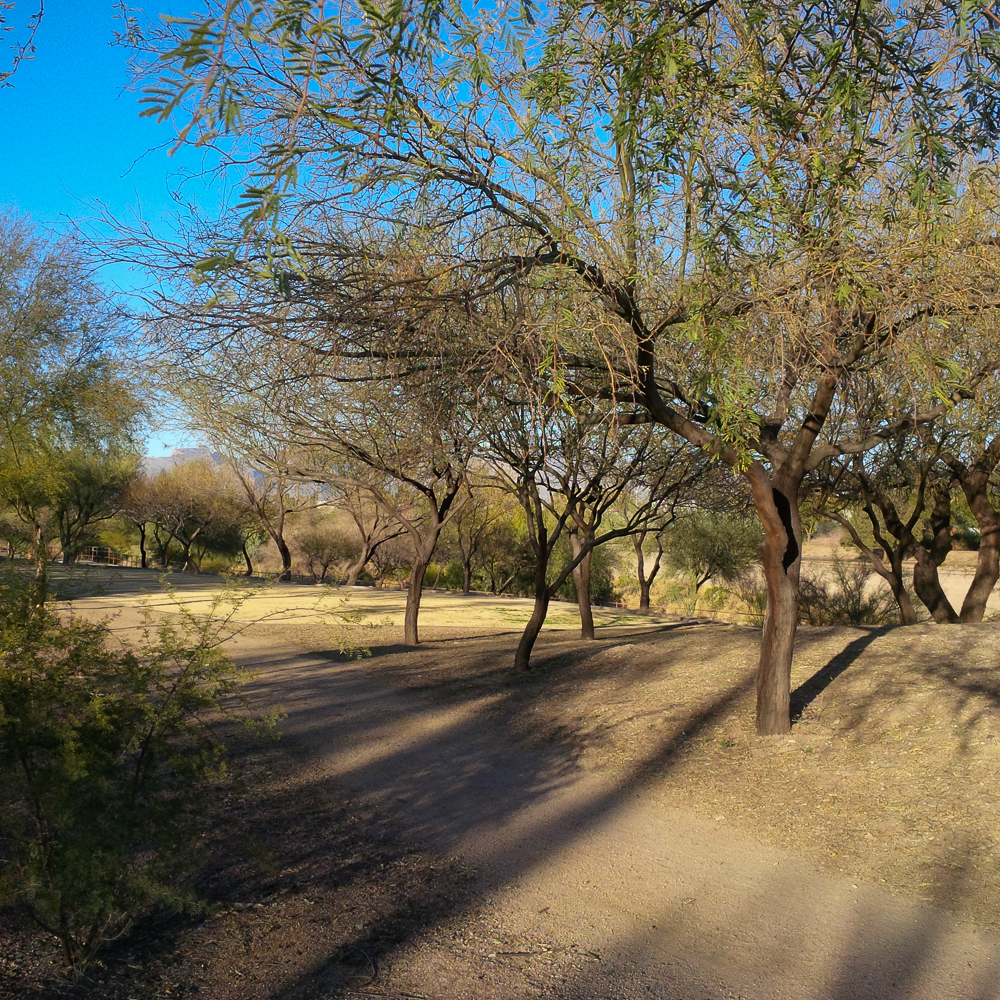
So, into the car and off to the shows all over town in search of fine minerals… but can I just make a small random observation first?
Our rental car flashed this at us regularly, throughout the trip:

I’m sorry, but if your brain is not already subconsciously running this question in the background for you every day, you’re gonna have issues. Waiting until a car prompts the thought is inadvisable.
OK. I’m done. On to the minerals. (It’s safe to move.)
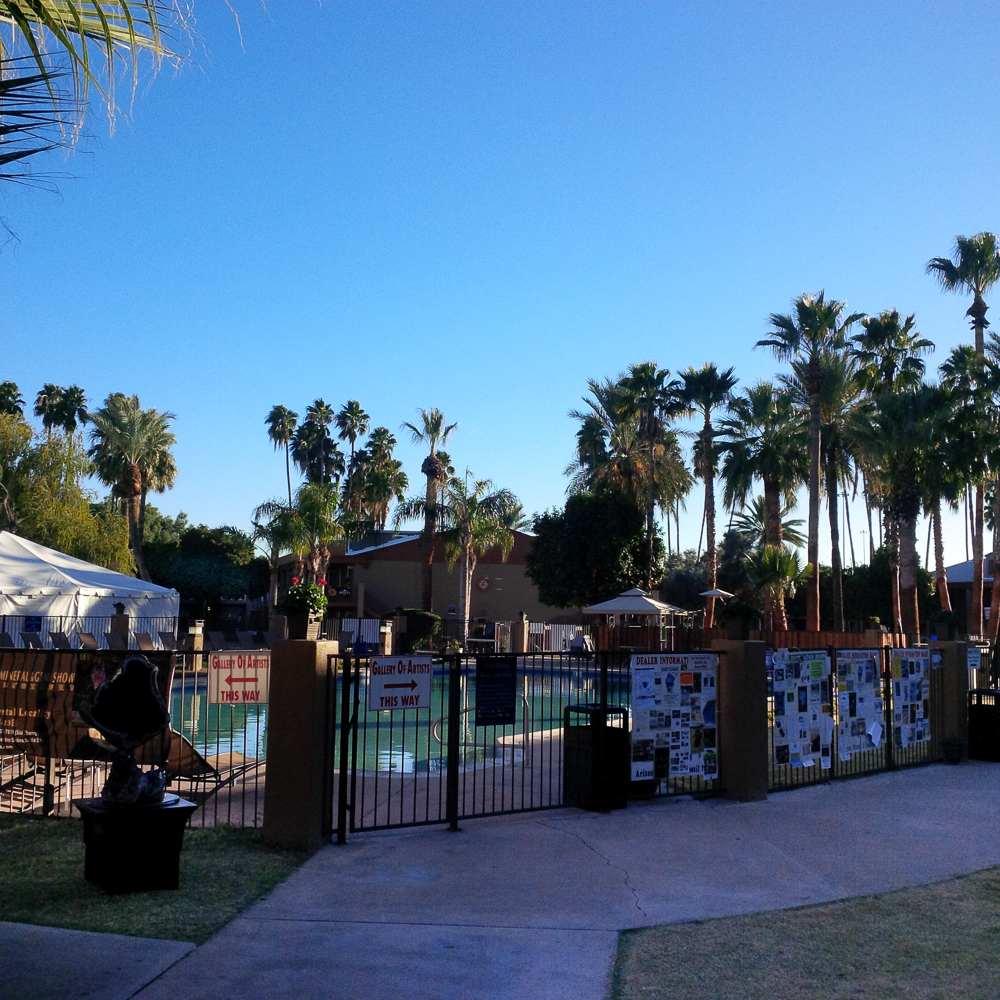 The courtyard mineral localities beckon…
The courtyard mineral localities beckon…
Minerals!
There were great mineral specimens in Tucson this year and this post is just a small glimpse of a few fun things I managed to acquire. Each of the following will be the subject of an update on the website over the coming weeks.
Let’s begin with a new find of gorgeous yellow fluorites from Morocco. These are from the classic fluorite locality, the El Hammam Mine, they are unusually sharp, yellow cubes.
The hue of these fluorites varies, depending on the light source (common for fluorite), from a warmer honey-yellow under halogen, to a slightly brighter yellow in daylight and even a bit bolder under cool-temperature LED lighting. (This effect is different with each specimen, some show it more and some less).
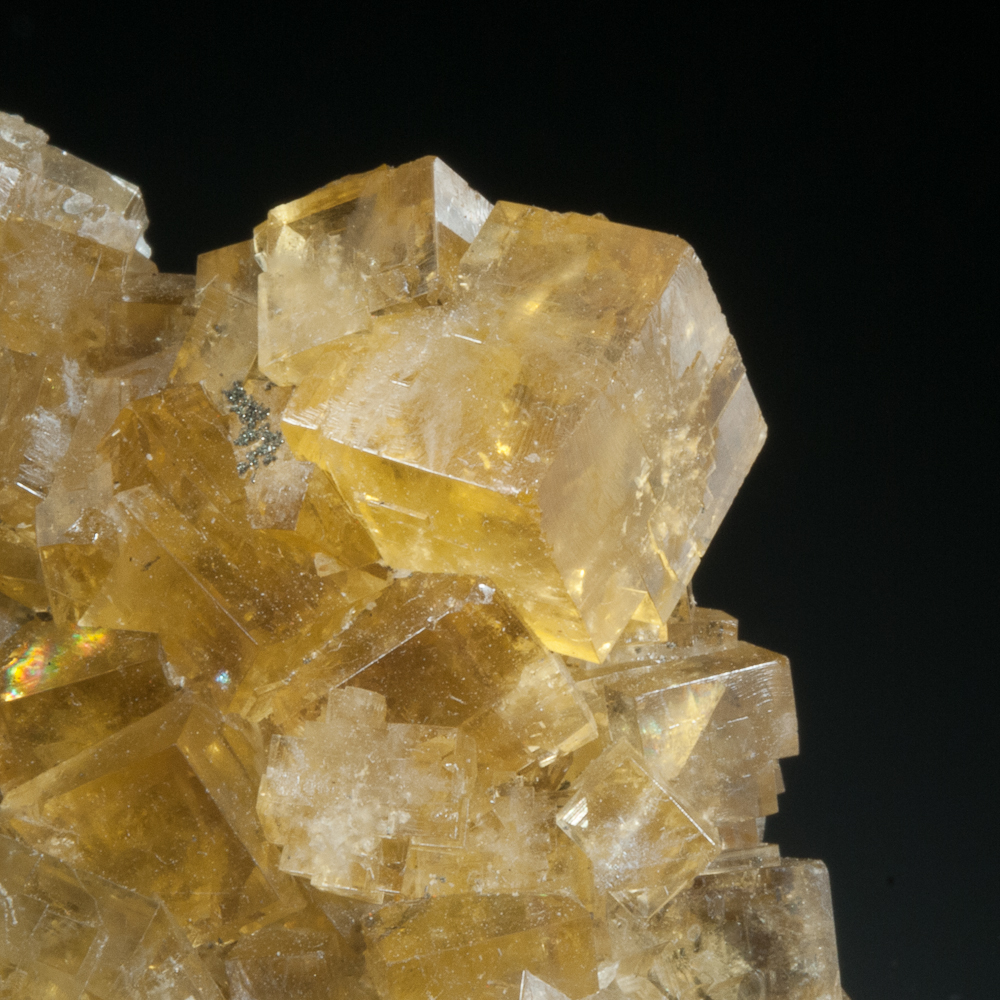 Fluorite, El Hammam Mine, Meknes, Meknes-Tafilalet Region, Morocco
Fluorite, El Hammam Mine, Meknes, Meknes-Tafilalet Region, Morocco
Field of view 4.0 cm
Upon close inspection, many of the crystals contain delicate, fine-lined purple phantoms.
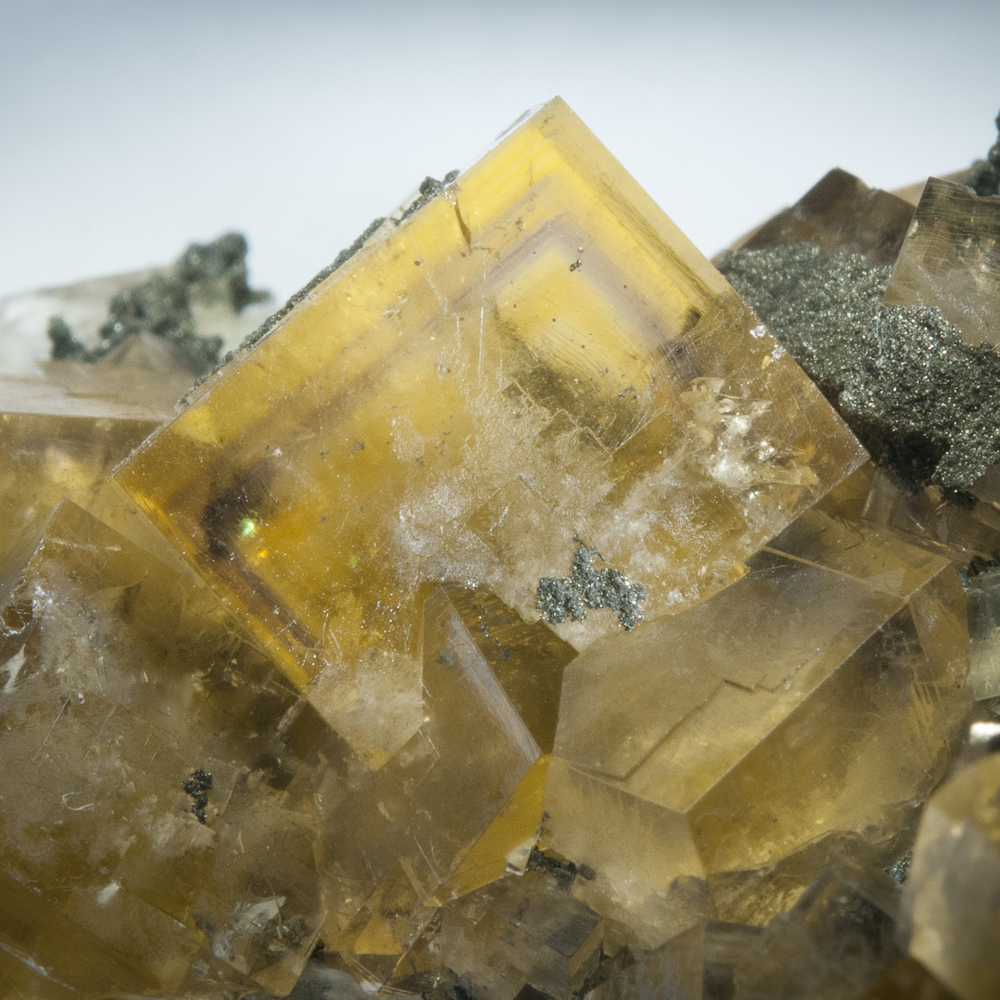 Fluorite, El Hammam Mine, Meknes, Meknes-Tafilalet Region, Morocco
Fluorite, El Hammam Mine, Meknes, Meknes-Tafilalet Region, Morocco
Field of view 2.5 cm
This was not a large find, and I chose the best quality ones available – if you’d like to see more photos, they are in the Morocco Fluorite update (click here).
Next up is the amazing Milpillas Mine in Mexico. It’s no surprise that we are continuing to see more azurites, and a few other things are trickling out too, but this time I was particularly interested in the brochantites. There are not so many (certainly nothing like the azurites) but these are super for the species, and I found a few excellent ones available this year.
Brochantite, Milpillas Mine, Cuitaca, Mun. de Santa Cruz, Sonora, Mexico – 3.9 cm
Brochantite, Milpillas Mine, Cuitaca, Mun. de Santa Cruz, Sonora, Mexico
Width of this group is 3.2 cm
A bit further away from home, there was a relatively small new find of axinite at Dalnegorsk, Russia. Of course, over the years, some beautiful axinite specimens have been found at Dalnegorsk, some have been identified as axinite-(Mn), some as axinite-(Fe), and I’m told that these ones are axinite-(Fe). As is always the case with axinite, it is incredibly difficult to obtain damage-free specimens, and most from this find did have chipping. However, a few were in superb condition!
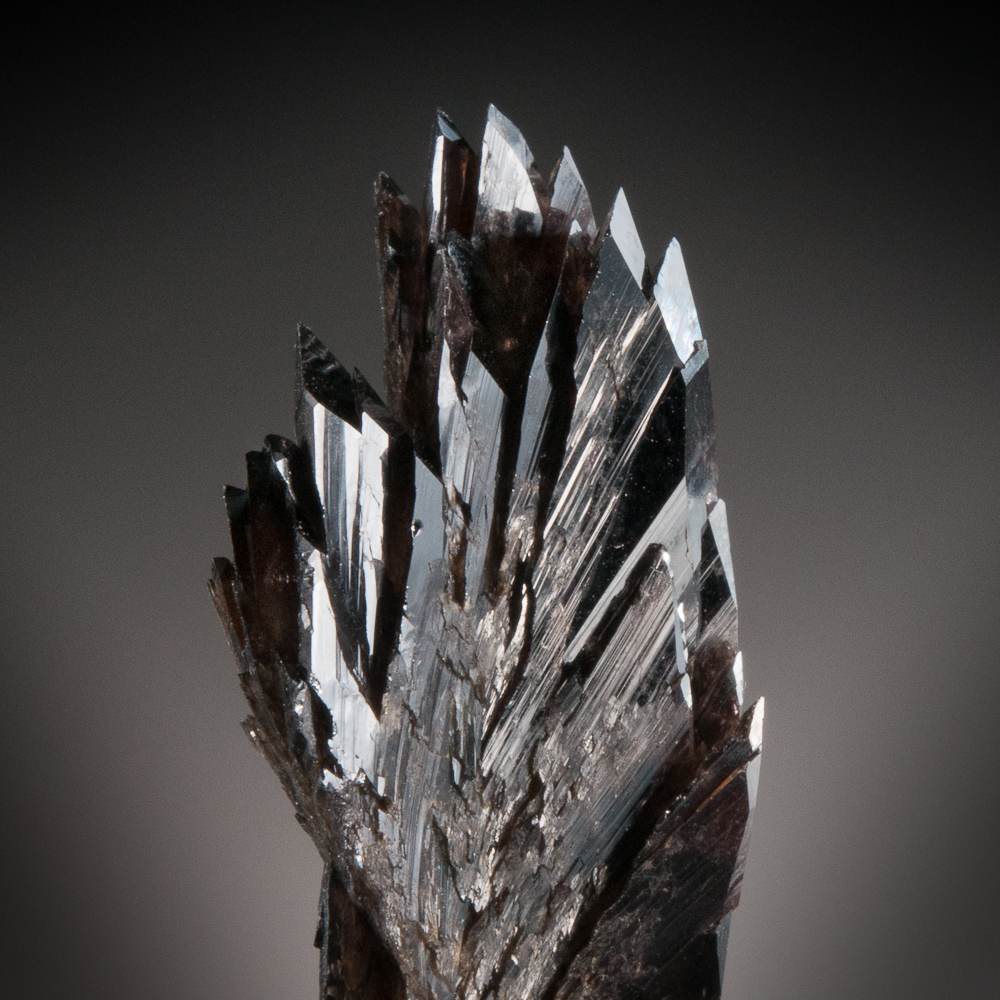 Axinite-(Fe), Bor Mine, Dal’negorsk, Primorskiy Kray, Russia
Axinite-(Fe), Bor Mine, Dal’negorsk, Primorskiy Kray, Russia
Field of view approximately 4 cm
Also from the Dalnegorsk mining complex, a newer mine has produced some wonderful new calcite specimens. The Yushnoe Mine is a newer mine and to date has produced virtually no fine mineral specimens. In 2015, a pocket of calcite crystals contained some beautiful twins. This was not a large or prolific find at all, and I found almost no specimens were undamaged, but I did find them! They show excellent twinning, with the same form as the now-classic twinned yellow calcites from the Sokolovskoe Mine, Rudniy, Kazakhstan. Beautiful!
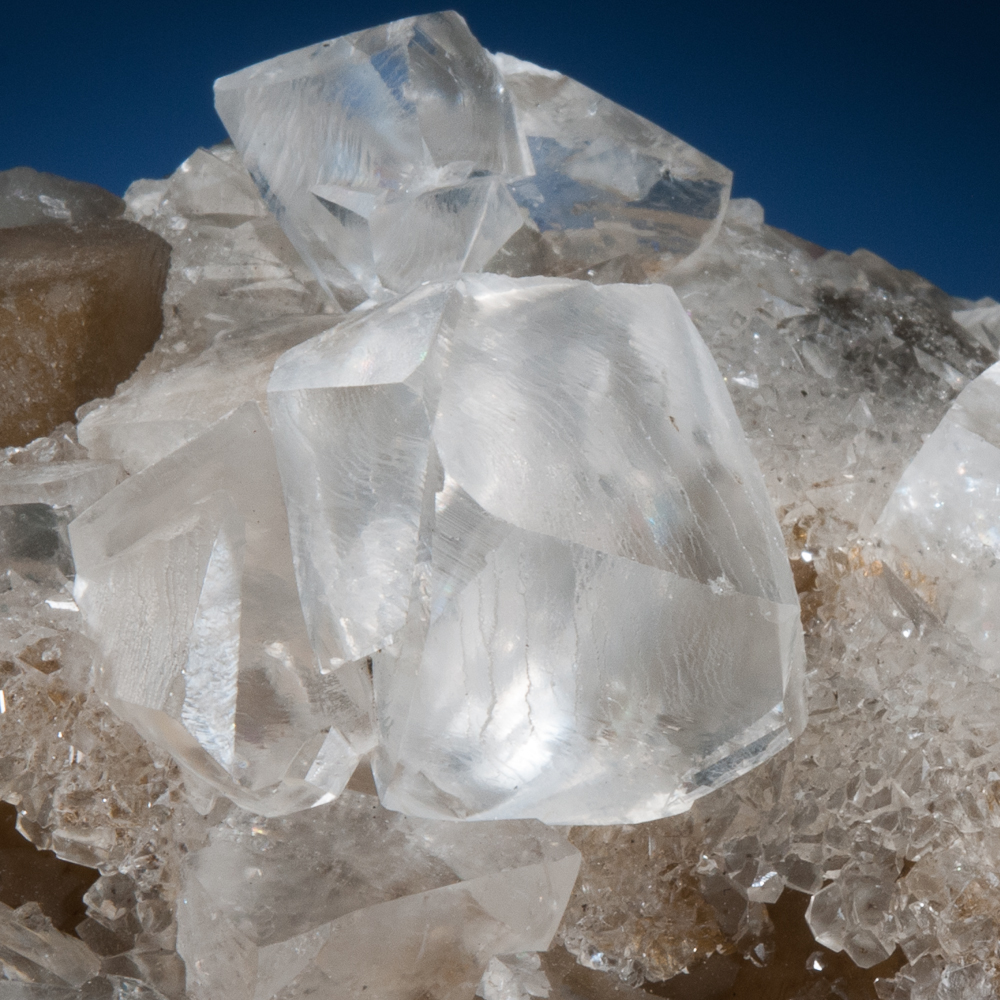 Calcite, Yushnoe Mine, Dal’negorsk, Primorskiy Kray, Russia
Calcite, Yushnoe Mine, Dal’negorsk, Primorskiy Kray, Russia
Field of view approximately 3.5 cm
From Canada, a recent expedition to Rapid Creek, Yukon, produced some fine lazulite specimens. This is a very remote locality and collecting there is so expensive that it is rarely undertaken these days. Many specimens from the find debuted in Tucson, and we (David K. Joyce and I) acquired the finest.
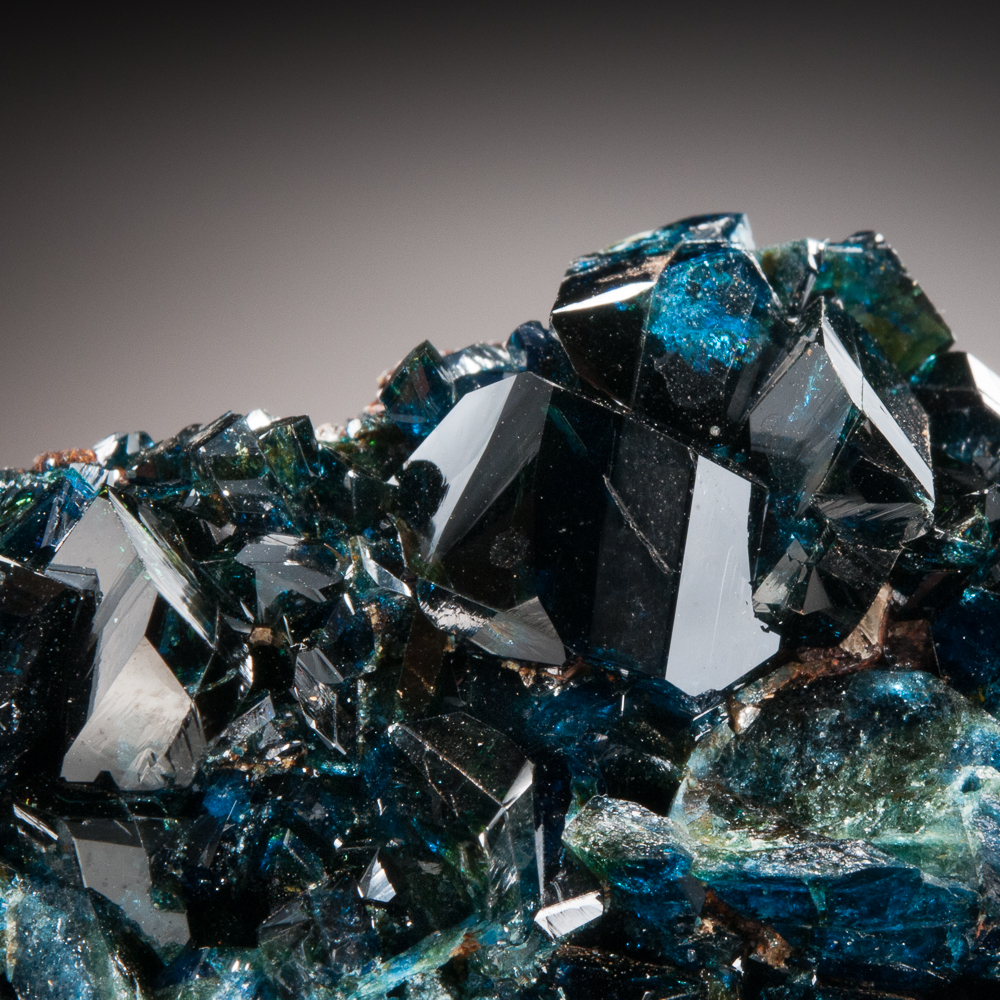
Lazulite, Rapid Creek, Dawson Mining District, Yukon, Canada
Largest crystal 1.5 cm
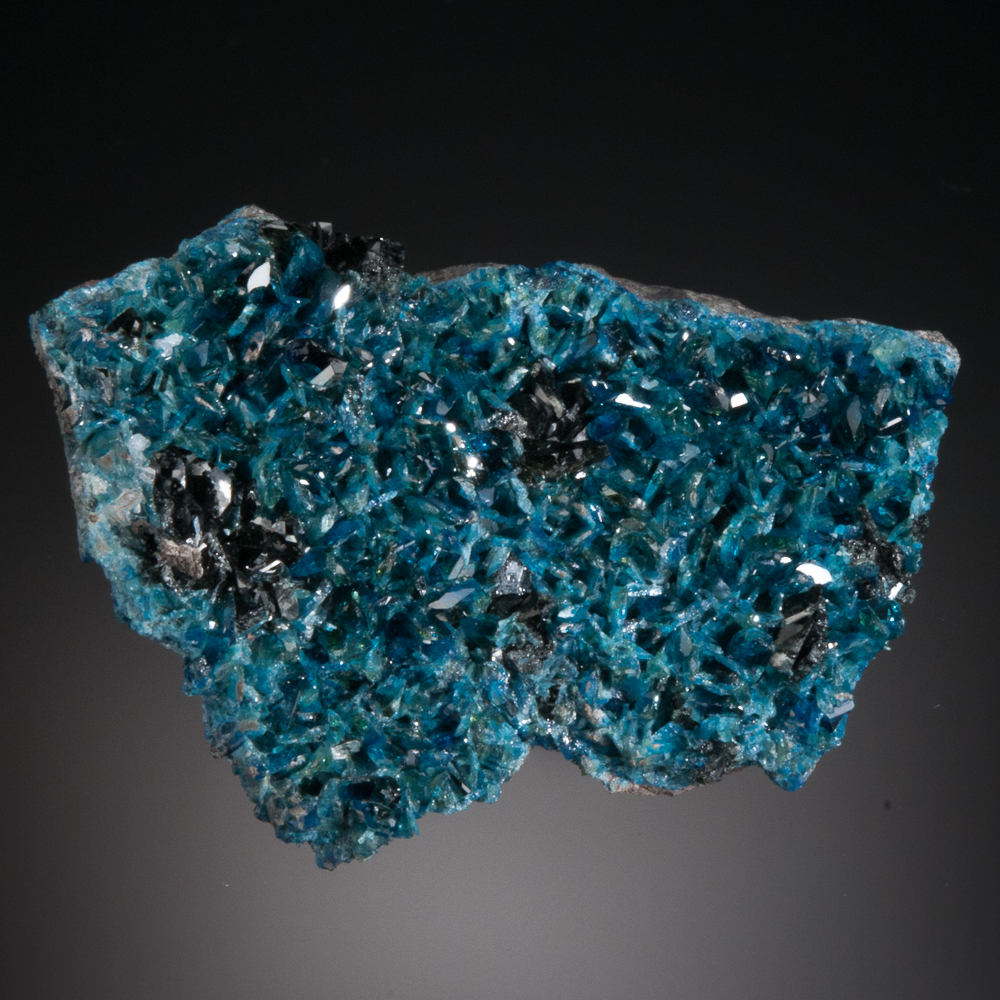 Lazulite with Kulanite, Rapid Creek, Dawson Mining District, Yukon, Canada – 5.7 cm
Lazulite with Kulanite, Rapid Creek, Dawson Mining District, Yukon, Canada – 5.7 cm
One of the great things about Tucson is of course the chance to reconnect with mineral friends and colleagues from all over the world, and sometimes they have brought some pretty amazing things along with them. Not all of these are new finds by any means, but sometimes some remarkable specimens surface in Tucson.
One such find was strontianite from an Austrian collection. Strontianite is a relatively common mineral, but great specimens are not common. Typically when we think of the mineral strontianite – let’s face it, IF we even think of it at all – we think of fuzzy-looking aggregates of tiny crystals or relatively unattractive specimens. Perhaps that’s not fair (sorry strontianite!) and there are of course exceptions, including a small number of specimens from Scotland, Illinois and the Alps. And some of the finest strontianite crystals in the world come from Oberdorf an der Laming, Laming valley, Bruck an der Mur, Styria, Austria. The crystals occur in a variety of habits, with quartz-like prisms, blocky hexagonal prisms and elongated dogtooth-style crystals. I was very happy to have found a small suite of exceptionally well-crystallized strontianites from Oberdorf an der Laming in Tucson.
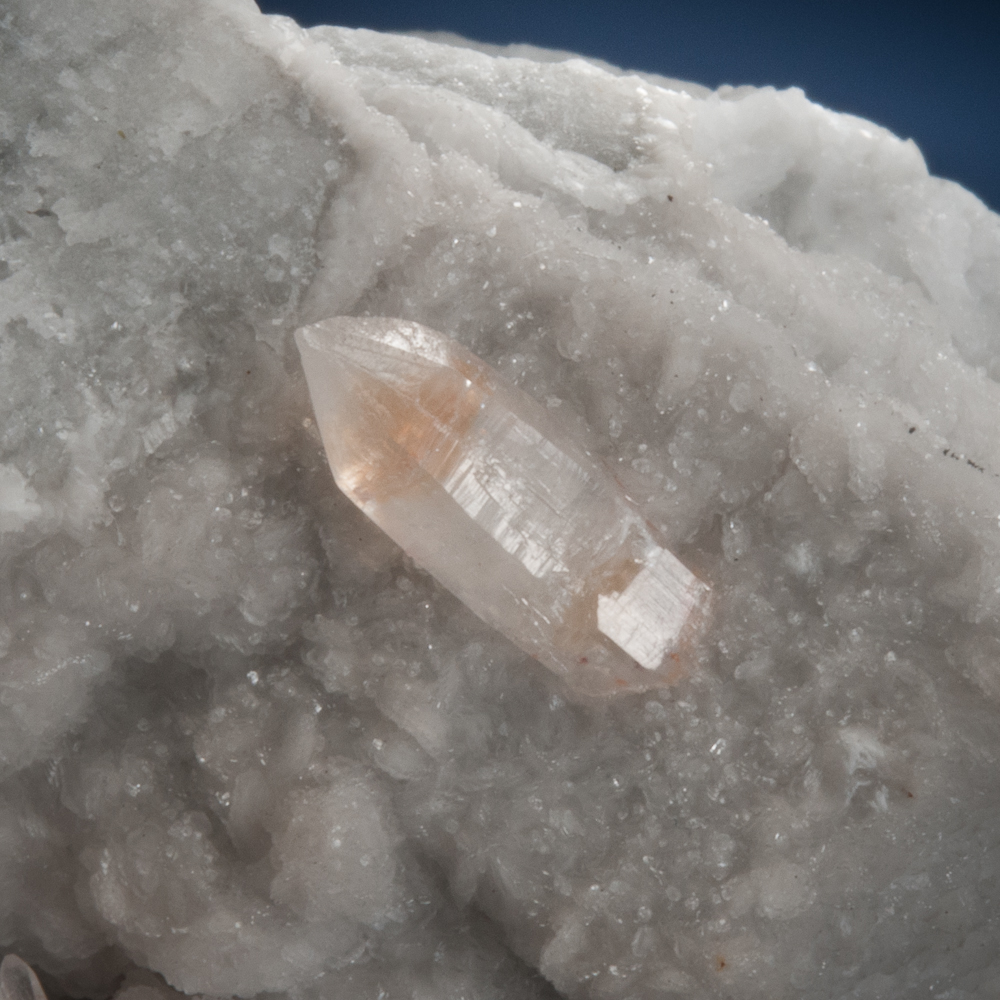 Strontianite, Oberdorf an der Laming, Laming valley, Bruck an der Mur, Styria, Austria
Strontianite, Oberdorf an der Laming, Laming valley, Bruck an der Mur, Styria, Austria
Crystal 1.2 cm
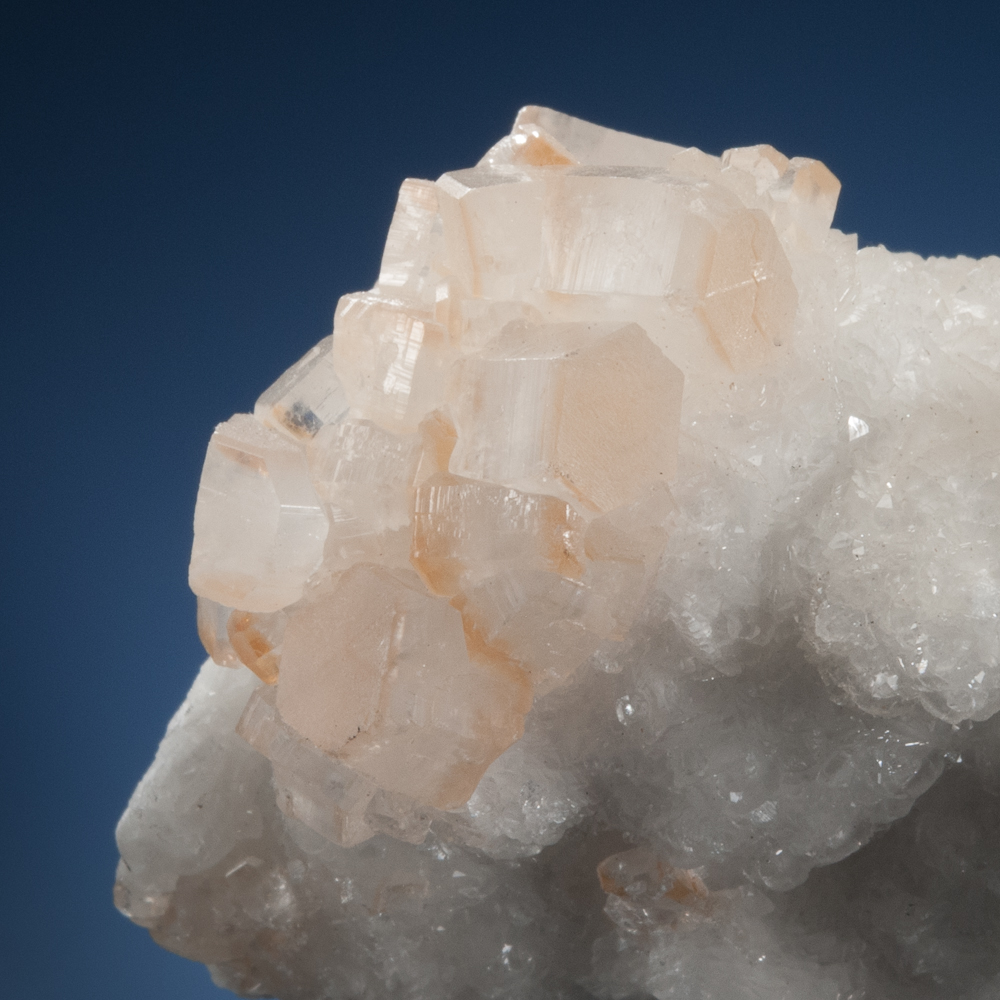 Strontianite, Oberdorf an der Laming, Laming valley, Bruck an der Mur, Styria, Austria
Strontianite, Oberdorf an der Laming, Laming valley, Bruck an der Mur, Styria, Austria
Field of view approximately 3.5 cm
Strontianite, Oberdorf an der Laming, Laming valley, Bruck an der Mur, Styria, Austria
Field of view approximately 2 cm
Another great thing about reconnecting with everyone in Tucson is the chance to learn from mineral friends. You know, we all end up with these specimens from all over the world, and then we take them back to our little lairs, and inevitably we have more work done on them. So there are always new finds, identifications, and re-identifications of minerals.
In Tucson this year, I learned that last year’s find of super tetrahedrite crystals at the Mundo Nuevo Mine was in fact a find of crystals of tennantite. Of a large number of specimens tested at Harvard, only one turned out to be tetrahedrite. Almost all turned out to be tennantite (a small number were intermediate, tennantite-dominant). Which is fun – they were already great tetrahedrite, but they are super for tennantite. I have a few left and although they are presumably tennantite, I have taken them off the site pending confirmatory analysis, and then they will be back on. For those of you who might not have seen them when I posted them originally, they are sharp and lustrous – here are a couple.
Tennantite, Mundo Nuevo Mine, Huamachuco, Sanchez Carrion Province, La Libertad Dept., Peru
Field of view 4.0 cm
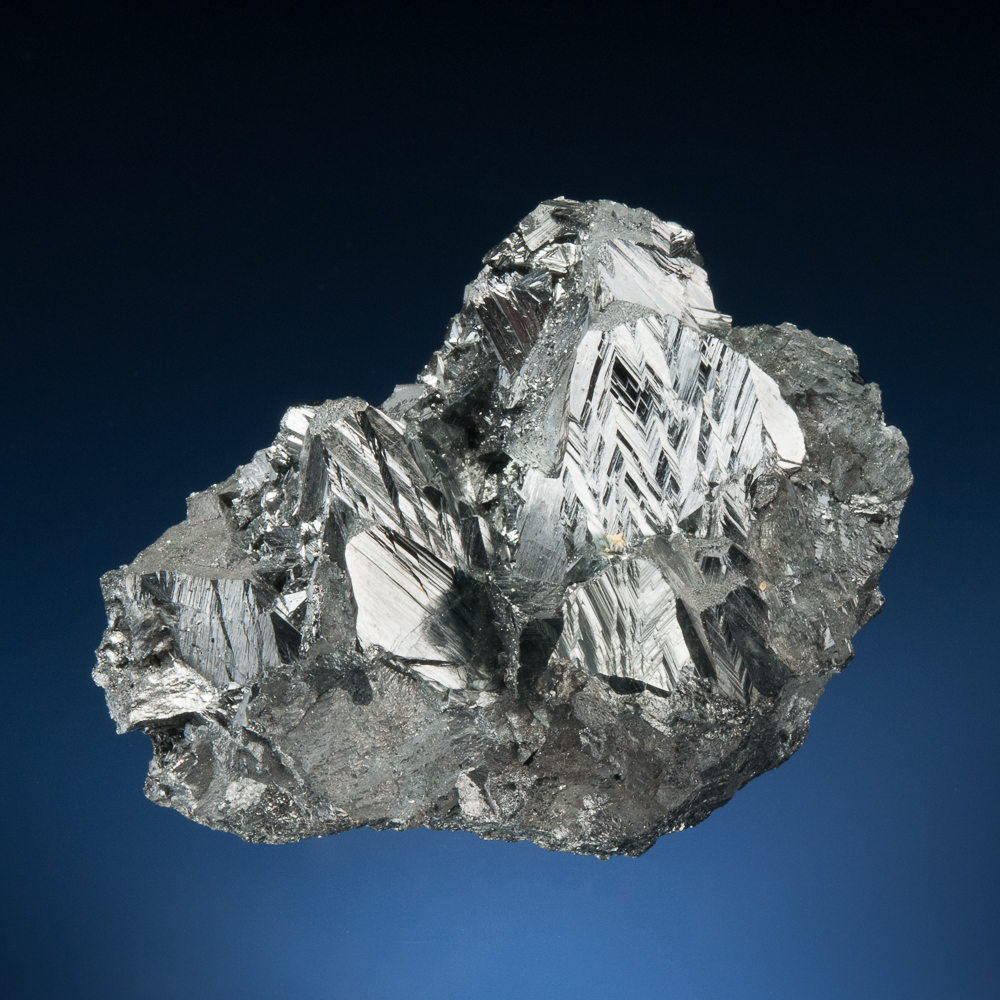 Tennantite, Mundo Nuevo Mine, Huamachuco, Sanchez Carrion Province, La Libertad Dept., Peru – 8.2 cm
Tennantite, Mundo Nuevo Mine, Huamachuco, Sanchez Carrion Province, La Libertad Dept., Peru – 8.2 cm
Related to this finding, it was also discovered that there are some tennantite specimens with the rare mineral lautite on them. These are microscopic crystals and rosettes – a mineral that is rarely found at all, let alone in crystals. Here’s a photo. (By the way, Dave still has a few of these lautites available on his website – I’m including a link to them at the end of this post, if you are interested.
Lautite, Mundo Nuevo Mine, Huamachuco, Sanchez Carrion Province, La Libertad Dept., Peru
Field of view 2mm.
David K. Joyce photo.
Speaking of identifications, one find that first came to light last year has turned out to be something special. Last year you may have seen (and may even have acquired) specimens of “chrysocolla over malachite pseudomorphs after azurite” from the Luputo Mine, Lubumbashi, Democratic Republic of the Congo. Thanks to analysis conducted by Dr. Hexiong Yang at the University of Arizona, we now know they are in fact not chrysocolla, but ajoite. This is a remarkable development – ajoite has not been known in display specimens, so this is a first! (Ajoite is best known from the ajoite-included quartz crystals from Musina, South Africa). I was very happy to be able to acquire a few of these specimens in Tucson!
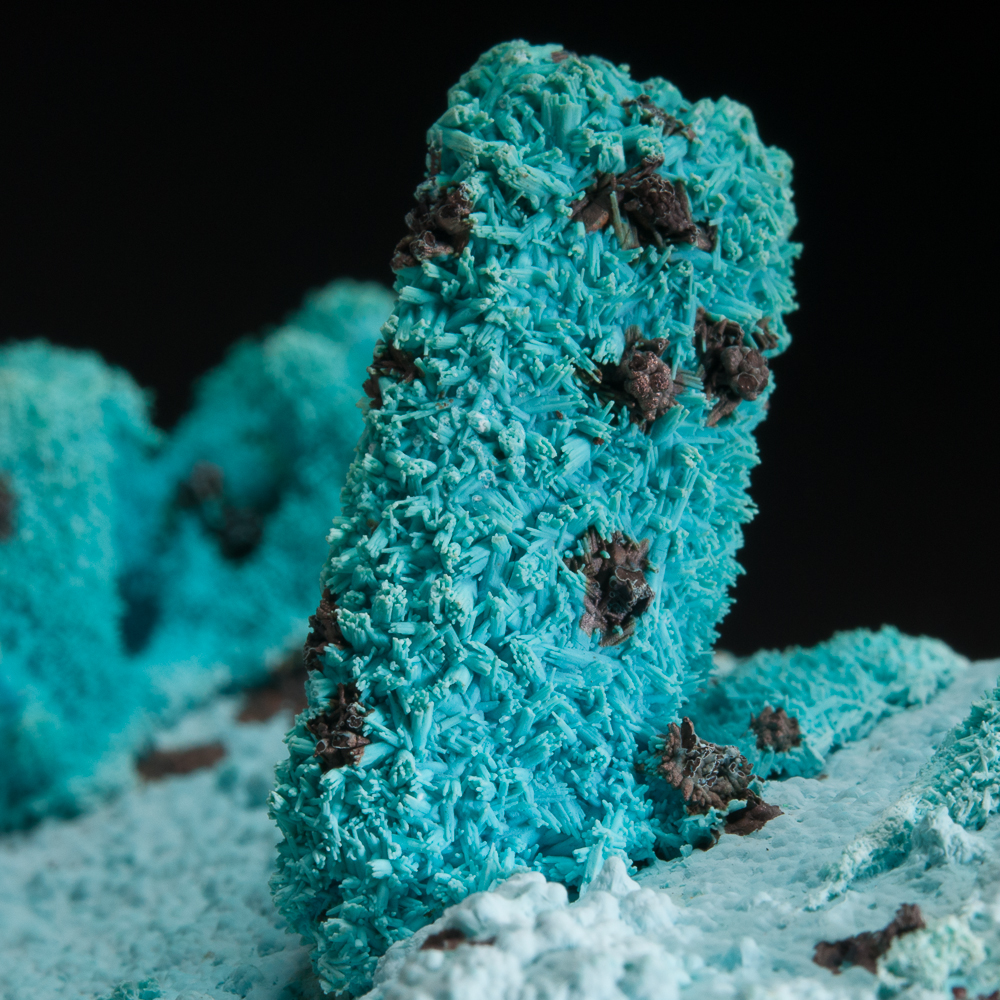 Ajoite over Malachite pseudomorph after Azurite
Ajoite over Malachite pseudomorph after Azurite
Luputo Mine, Lubumbashi, Democratic Republic of the Congo
Field of view 3.5 cm
Ajoite over Malachite pseudomorph after Azurite
Luputo Mine, Lubumbashi, Democratic Republic of the Congo
Field of view 2.5 cm
Tucson Beyond the Minerals
I’ll spare you the stories of all of the great get-togethers with mineral friends, but I’d like to share a couple.
Canadian collector and dealer Ray Hill hosts fun dinners at his rented place in Tucson each year. Not only is he a great cook, but he also assembles such good groups together that it is always both interesting and a good time. The group included Ray Hill, David Joyce, John Montgomery, Marie and Terry Huizing, David Wilber and Larry Venezia. I wish I had a photo from this evening’s highlight, but it was too dark out to capture the mood without a proper camera setup. Ray had brought a portable propane campfire from Canada. (Never seen one before…) After dinner we moved outdoors… and what is a campfire without a song or two? Many of you know that David Joyce has written, and plays and sings, great mineral songs (link at the end of this post) – so Dave brought out his guitar and we had good fun singing mineral songs around our Tucson campfire under the stars.
The other one I’d like to share is a photo from a dinner we look forward to every year, with Si and Ann Frazier, and Frank and Wendy Melanson. Always a fun evening, with good food, stories, laughs, and some mineral show-and tell, so it’s hardly a time that prompts serious reflection (!). However when I was looking at this photo afterward, I was struck by the knowledge and experience in this room. You are looking not only at five of the most knowledgeable mineral people out there, but the five people in this photograph have been responsible, directly and indirectly, for the preservation and placement of uncounted tens of thousands of the world’s fine mineral specimens into museums and private collections.
From left to right, Si and Ann Frazier, Wendy Melanson, David K. Joyce and Frank Melanson
Although we all wish Tucson would never end, somehow it ends too soon every year…
Last sunlight, as Tucson shadows fall
Happy to be back home, to the forest shadows…
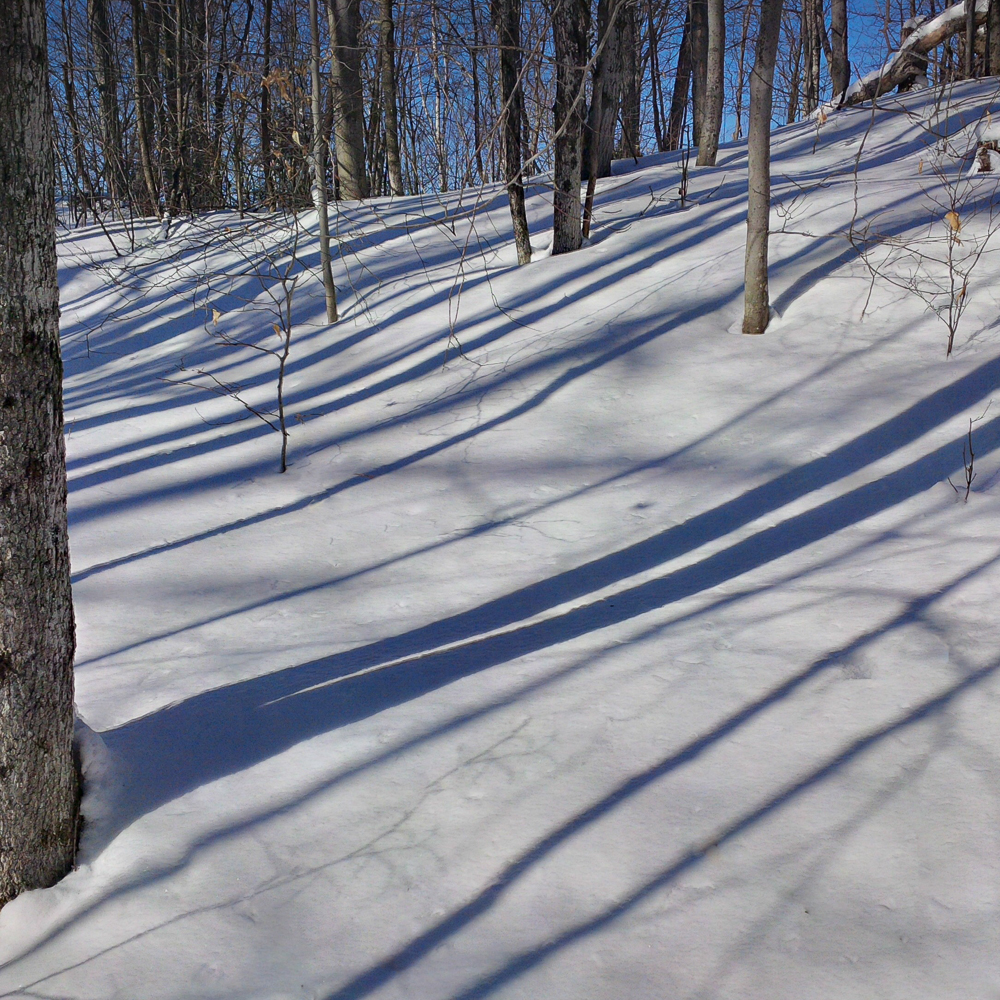
… and where the snow crunches underfoot with each step in the winter woods.
Links
(1) For the lautite specimens at davidkjoyceminerals.com, click here.
(2) For the mineral songs click here (“The Mineral Dealer” is an awesome song for Tucson season.)


